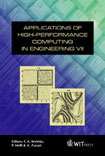A Parallel Algorithm With Time Dependent Mesh Refinement For Wave Propagation Problems
Price
Free (open access)
Volume
27
Pages
Published
2002
Size
533 kb
Paper DOI
10.2495/HPC020041
Copyright
WIT Press
Author(s)
K. –H. Elmer
Abstract
A parallel algorithm with time dependent mesh refinement for wave propagation problems K.-H. Elmer Curt-Risch-Institute for Dynamics, Acoustics and Measurement Techn., University of Hannover; Germany. Abstract The realistic complex behavior of mechanical wave propagation problems and acoustic problems in transient dynamics with a broad frequency range requires very large systems and many time steps, to obtain reliable numerical solutions with sufficient high accuracy. This is a domain of todays high-performance computers. A fast three dimensional parallel Finite-Difference algorithm with time depen- dent mesh refinement is developed to analyse and visualise the complex behavior of traveling waves in transient dynamics and acoustics. The propagation of mechanical waves is characterized by the change and inter- action of strain energy and kinetic energy in space and time. According to this, the presented algorithm is based on the solution of the three-dimensional wave equation as a first order formulation in terms of stresses and velocities or acoustic pressure and particle velocity, representing both forms of energy in a direct way. Using explicit time integration and lumped mass description the equations of all nodes of the FD-method are decoupled. This leads to a very efficient algorithm, inherent parallel, and best suited to all kinds of parallel computing. The parallel FD-program is implemented on a 16 processor CRAY T3E parallel computer with distributed memory. The parallel efficiency of the algorithm and the efficiency of the time dependent mesh refinement are examined. Because of the small storage required and the short computational time, numerical investigations of large systems with online graphic simulations are possible up to several million degrees of freedom.
Keywords




